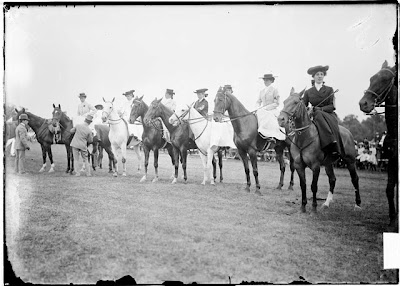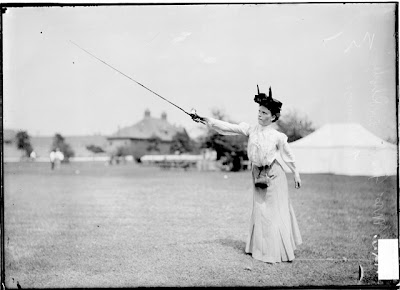 The employment of Boston women in 1905 was the subject of a recent post, with an emphasis on the broad range of work available to them. There were, however, a number of job categories which included NO women employees, and I've aggregated them below.
The employment of Boston women in 1905 was the subject of a recent post, with an emphasis on the broad range of work available to them. There were, however, a number of job categories which included NO women employees, and I've aggregated them below.Government Mandate
There were obviously no women soldiers, sailors, or marines!
Building Trades
These jobs formed the largest block of professions not available to women in 1905. They included contractors, carpenters, plasterers, paperhangers, roofers, electricians, plumbers, copper workers, and masons. There were six brave women who listed their profession as painter/glazier/varnisher, and 26 women in miscellaneous woodworking jobs (though these could have been artisans rather than builders).
Work Involving Horses
 Women rode or drove horses in 1905, but apparently work involving horses was not considered appropriate. There were no women grooms, stable workers, livery stable keepers, or harness and saddle makers/repairers.
Women rode or drove horses in 1905, but apparently work involving horses was not considered appropriate. There were no women grooms, stable workers, livery stable keepers, or harness and saddle makers/repairers.Seafaring Work
 While women went to sea in this era with their husbands (Cynthia's mother was often at sea with Cynthia's captain-father), and went fishing privately (or canoeing with their boyfriends), they did not work in sea-related jobs. So there were no women fishermen (or oystermen!), boatmen, steamship employees, or vessel builders/repairers. Certainly, the seafaring jobs were subject to the same cultural restraints as military work--with resistance from the men themselves as well as from their wives.
While women went to sea in this era with their husbands (Cynthia's mother was often at sea with Cynthia's captain-father), and went fishing privately (or canoeing with their boyfriends), they did not work in sea-related jobs. So there were no women fishermen (or oystermen!), boatmen, steamship employees, or vessel builders/repairers. Certainly, the seafaring jobs were subject to the same cultural restraints as military work--with resistance from the men themselves as well as from their wives.Alcohol-Related Work
Women were apparently too pure and sensitive to work in alchohol-related professions. So there were no women brewers/maltsters or bartenders. (A number of women, however, were restaurant and saloon-keepers--apparently that was OK as long as you didn't get behind the bar!)
Other Work Considered Too Dangerous, Dirty, or Physical for Women
 In this category I've included heavy duty manufacturing (carriage and wagon factory workers and steam boiler makers), transportation/telecommunications work (railway engineers, street railway employees, telegraph/telephone linemen, wheelwrights), and metal and machine workers (blacksmiths, gunsmiths, locksmiths, bellhangers, machinists, and mechanics). There were no women "porters and helpers (in stores, etc.)", since presumably this involved heavy lifting. There were also no women butchers or coopers (barrel makers).
In this category I've included heavy duty manufacturing (carriage and wagon factory workers and steam boiler makers), transportation/telecommunications work (railway engineers, street railway employees, telegraph/telephone linemen, wheelwrights), and metal and machine workers (blacksmiths, gunsmiths, locksmiths, bellhangers, machinists, and mechanics). There were no women "porters and helpers (in stores, etc.)", since presumably this involved heavy lifting. There were also no women butchers or coopers (barrel makers).Cultural Barriers
There were no women working as engineers and surveyors or as model and pattern makers (though there were a handful of women architects, designers, and draughtsmen). This work may have seemed more suited to the male "logical" mind, and certainly there would have been a barrier to the engineering work done as part of the building trades. It's probably also true that relatively few women were prepared mathematically for professions like these (a problem that unfortunately still persists in some forms today).
There were no women piano tuners. This seems surprising because of the large number of women working as musicians and music teachers.
A Modern Footnote
Some of the employment areas discussed above are still the most difficult for women to enter. Only 10-12% of engineers in the US are women. Only 3.5% of telephone linemen in Canada are women (couldn't find a US statistic, but I assume it's comparable). In the building trades, only 3% of jobs are held by women.
Illustration Credits and References
Census data from Census of the the Commonwealth of Massachusetts, 1905. Volume 2: Occupations and Defective Social and Physical Conditions.
The photographs were all taken in greater Chicago in 1905, and are from the Chicago Daily News Negative Collection. They are part of a wonderful collection of Chicago Daily News photographs that are accessible on the Library of Congress American Memory website. I'm assuming there are comparable Boston area photos--if you're aware of any, please let me know!
FIrst photo: Mrs. F. W. Hedgeland driving a car down a neighborhood street in Chicago with two women in the backseat. Credit: SDN-003345, Chicago Daily News negatives collection, Chicago Historical Society.
Second photo: Women on horses at the Onwentsia Horse Show in Lake Forest, Illinois. Credit: DN-0002809, Chicago Daily News negatives collection, Chicago Historical Society.
Third photo: Full-length portrait of Mrs. E. B. Bartholomew, Michigan, fly fisher, demonstrating casting in a park, in Chicago. Credit: SDN-003372, Chicago Daily News negatives collection, Chicago Historical Society.
Fourth photo: Club women standing in a train station in Chicago. Credit: DN-0002306, Chicago Daily News negatives collection, Chicago Historical Society.
No comments:
Post a Comment